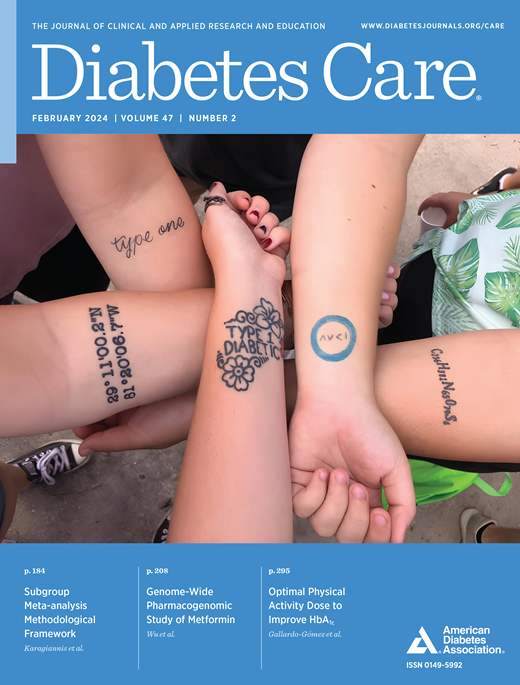Association Between Use of Sodium–Glucose Cotransporter 2 Inhibitors and Epilepsy: A Population-Based Study Using Target Trial Emulation
IF 16.6
1区 医学
Q1 ENDOCRINOLOGY & METABOLISM
引用次数: 0
Abstract
OBJECTIVE Preclinical studies in animals have suggested potential neuroprotective effects of sodium–glucose cotransporter 2 inhibitors (SGLT-2is), but no epidemiological study has investigated the potential effects of SGLT-2is on epilepsy risk. We aimed to assess the association between use of SGLT-2is and epilepsy incidence. RESEARCH DESIGN AND METHODS We emulated a target trial comparing SGLT-2is and dipeptidyl peptidase 4 inhibitors (DPP-4is) based on the Yinzhou Regional Health Care Database. Cohorts of patients with type 2 diabetes mellitus who were new users of an SGLT-2i or a DPP-4i were assembled. Inverse probability of treatment weighting (IPTW) and Cox proportional hazards regression modeling were applied to estimate the hazard ratio (HR) and 95% CI of the association between use of SGLT-2is and incidence of epilepsy. RESULTS The final cohort included 24,930 new users of SGLT-2is and 28,924 initiators of DPP-4is. A total of 243 patients with incident epilepsy were found during a median follow-up of 2.0 (interquartile range 0.8–3.3) years, with the incidence of epilepsy being 174.2 and 231.5 per 100,000 person-years in users of SGLT-2is and DPP-4is, respectively. After controlling for potential confounding using IPTW, SGLT-2i use was associated with a lower incidence of epilepsy, with an HR of 0.71 (95% CI 0.52–0.97). Various subgroup analyses and sensitivity analyses supported the results in primary analyses. CONCLUSIONS SGLT-2is were associated with a reduced incidence of epilepsy in the study population. More studies are needed to confirm and replicate the study results.钠-葡萄糖共转运蛋白2抑制剂与癫痫之间的关系:一项基于人群的目标试验模拟研究
目的动物临床前研究提示钠-葡萄糖共转运蛋白2抑制剂(SGLT-2is)具有潜在的神经保护作用,但尚未有流行病学研究调查SGLT-2is对癫痫风险的潜在影响。我们的目的是评估使用sglt -2与癫痫发病率之间的关系。研究设计与方法基于鄞州地区卫生保健数据库,对SGLT-2is和二肽基肽酶4抑制剂(DPP-4is)进行了模拟试验。对新使用SGLT-2i或DPP-4i的2型糖尿病患者进行分组。应用治疗加权逆概率(Inverse probability of treatment weighting, IPTW)和Cox比例风险回归模型估计sglt -2使用与癫痫发病率之间关联的风险比(hazard ratio, HR)和95% CI。最终队列包括24,930名SGLT-2is新使用者和28,924名DPP-4is起始者。在中位随访2.0年(四分位数间距0.8-3.3年)期间,共发现243例癫痫患者,sglt -2和dpp -4患者的癫痫发病率分别为每10万人年174.2例和231.5例。在使用IPTW控制潜在的混杂因素后,SGLT-2i的使用与较低的癫痫发病率相关,风险比为0.71 (95% CI 0.52-0.97)。各种亚组分析和敏感性分析支持初步分析的结果。结论:在研究人群中,sglt -2与癫痫发病率降低相关。需要更多的研究来证实和重复研究结果。
本文章由计算机程序翻译,如有差异,请以英文原文为准。
求助全文
约1分钟内获得全文
求助全文
来源期刊

Diabetes Care
医学-内分泌学与代谢
CiteScore
27.80
自引率
4.90%
发文量
449
审稿时长
1 months
期刊介绍:
The journal's overarching mission can be captured by the simple word "Care," reflecting its commitment to enhancing patient well-being. Diabetes Care aims to support better patient care by addressing the comprehensive needs of healthcare professionals dedicated to managing diabetes.
Diabetes Care serves as a valuable resource for healthcare practitioners, aiming to advance knowledge, foster research, and improve diabetes management. The journal publishes original research across various categories, including Clinical Care, Education, Nutrition, Psychosocial Research, Epidemiology, Health Services Research, Emerging Treatments and Technologies, Pathophysiology, Complications, and Cardiovascular and Metabolic Risk. Additionally, Diabetes Care features ADA statements, consensus reports, review articles, letters to the editor, and health/medical news, appealing to a diverse audience of physicians, researchers, psychologists, educators, and other healthcare professionals.
 求助内容:
求助内容: 应助结果提醒方式:
应助结果提醒方式:


